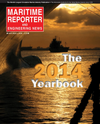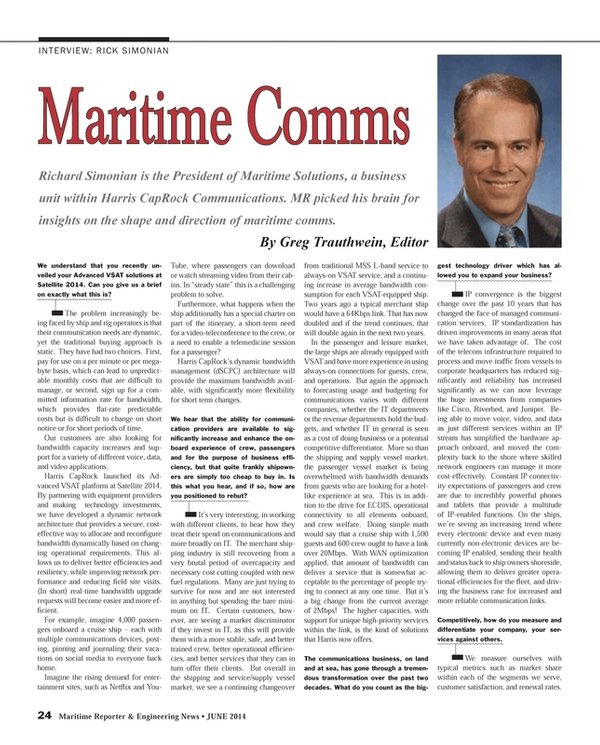
Maritime Communication: A Bold New Shape and Direction
Richard Simonian is the President of Maritime Solutions, a business unit within Harris CapRock Communications. MR picked his brain for insights on the shape and direction of maritime comms.
We understand that you recently unveiled your Advanced VSAT solutions at Satellite 2014. Can you give us a brief on exactly what this is?
The problem increasingly being faced by ship and rig operators is that their communication needs are dynamic, yet the traditional buying approach is static. They have had two choices. First, pay for use on a per minute or per megabyte basis, which can lead to unpredictable monthly costs that are difficult to manage, or second, sign up for a committed information rate for bandwidth, which provides flat-rate predictable costs but is difficult to change on short notice or for short periods of time.
Our customers are also looking for bandwidth capacity increases and support for a variety of different voice, data, and video applications.
Harris CapRock launched its Advanced VSAT platform at Satellite 2014. By partnering with equipment providers and making technology investments, we have developed a dynamic network architecture that provides a secure, cost-effective way to allocate and reconfigure bandwidth dynamically based on changing operational requirements. This allows us to deliver better efficiencies and resiliency, while improving network performance and reducing field site visits. (In short) real-time bandwidth upgrade requests will become easier and more efficient.
For example, imagine 4,000 passengers onboard a cruise ship – each with multiple communications devices, posting, pinning and journaling their vacations on social media to everyone back home.
Imagine the rising demand for entertainment sites, such as Netflix and YouTube, where passengers can download or watch streaming video from their cabins. In “steady state” this is a challenging problem to solve.
Furthermore, what happens when the ship additionally has a special charter on part of the itinerary, a short-term need for a video-teleconference to the crew, or a need to enable a telemedicine session for a passenger?
Harris CapRock’s dynamic bandwidth management (dSCPC) architecture will provide the maximum bandwidth available, with significantly more flexibility for short term changes.
We hear that the ability for communication providers are available to significantly increase and enhance the onboard experience of crew, passengers and for the purpose of business efficiency, but that quite frankly shipowners are simply too cheap to buy in. Is this what you hear, and if so, how are you positioned to rebut?
It’s very interesting, in working with different clients, to hear how they treat their spend on communications and more broadly on IT. The merchant shipping industry is still recovering from a very brutal period of overcapacity and necessary cost cutting coupled with new fuel regulations. Many are just trying to survive for now and are not interested in anything but spending the bare minimum on IT. Certain customers, however, are seeing a market discriminator if they invest in IT, as this will provide them with a more stable, safe, and better trained crew, better operational efficiencies, and better services that they can in turn offer their clients. But overall in the shipping and service/supply vessel market, we see a continuing changeover from traditional MSS L-band service to always-on VSAT service, and a continuing increase in average bandwidth consumption for each VSAT-equipped ship. Two years ago a typical merchant ship would have a 64Kbps link. That has now doubled and if the trend continues, that will double again in the next two years.
In the passenger and leisure market, the large ships are already equipped with VSAT and have more experience in using always-on connections for guests, crew, and operations. But again the approach to forecasting usage and budgeting for communications varies with different companies, whether the IT departments or the revenue departments hold the budgets, and whether IT in general is seen as a cost of doing business or a potential competitive differentiator. More so than the shipping and supply vessel market, the passenger vessel market is being overwhelmed with bandwidth demands from guests who are looking for a hotel-like experience at sea. This is in addition to the drive for ECDIS, operational connectivity to all elements onboard, and crew welfare. Doing simple math would say that a cruise ship with 1,500 guests and 600 crew ought to have a link over 20Mbps. With WAN optimization applied, that amount of bandwidth can deliver a service that is somewhat acceptable to the percentage of people trying to connect at any one time. But it’s a big change from the current average of 2Mbps! The higher capacities, with support for unique high-priority services within the link, is the kind of solutions that Harris now offers.
The communications business, on land and at sea, has gone through a tremendous transformation over the past two decades. What do you count as the biggest technology driver which has allowed you to expand your business?
IP convergence is the biggest change over the past 10 years that has changed the face of managed communication services. IP standardization has driven improvements in many areas that we have taken advantage of. The cost of the telecom infrastructure required to process and move traffic from vessels to corporate headquarters has reduced significantly and reliability has increased significantly as we can now leverage the huge investments from companies like Cisco, Riverbed, and Juniper. Being able to move voice, video, and data as just different services within an IP stream has simplified the hardware approach onboard, and moved the complexity back to the shore where skilled network engineers can manage it more cost-effectively. Constant IP connectivity expectations of passengers and crew are due to incredibly powerful phones and tablets that provide a multitude of IP-enabled functions. On the ships, we’re seeing an increasing trend where every electronic device and even many currently non-electronic devices are becoming IP enabled, sending their health and status back to ship owners shoreside, allowing them to deliver greater operational efficiencies for the fleet, and driving the business case for increased and more reliable communication links.
Competitively, how do you measure and differentiate your company, your services against others.
We measure ourselves with typical metrics such as market share within each of the segments we serve, customer satisfaction, and renewal rates. By several third-party measures, Harris CapRock has continued to increase market share in both energy and maritime markets, demonstrating our corporate commitment to these customers. As a Fortune 500 company specializing in communications, one of Harris’ differentiators is the enormous breadth and depth of expertise we offer our clients in all forms of communications, not just satellite. We have helped many customers architect their entire end-to-end service, inclusive of terrestrial, WAN, LAN, satellite, and other wireless links.
We also bring unique innovation to the market, both technical innovation and business innovation. Examples of technology innovation include the previously mentioned Advanced VSAT offering. We have also stood up the largest global mobility network running the latest generation of TDMA satellite technology using iDirect. We have recently installed the very first O3bMaritime antennas and service for Royal Caribbean, offering an unprecedented 500 times the bandwidth to a single ship than has typically been available. Our direct involvement with putting hardware on new satellites such as Inmarsat Global Xpress and Iridium NEXT, communication packages on drones, and innovative long-range network radios ensures that we are very familiar with new communication technologies. This knowledge allows us to make the “best fit” recommendations to customers based on their needs and usage trends.
Looking at the Legislative arena, are there any issues on the horizon that could be good or bad for your business? Please be specific.
Some legislative changes are clearly driving higher bandwidth requirements and higher availability requirements. For example, MLC2006 will be incrementally implemented by companies around the world, but generally it will provide for more access to communications to the crew. The requirements for ECIDIS, paperless charts, electronic manifests, and ship tracking will similarly increase not only the bandwidth consumed by each ship but also the need for a highly available service rather than a “best effort” delivery that some vessels currently experience.
As a service provider we also closely track, and influence where appropriate, the regulatory changes affecting communications in different jurisdictions around the world. There are ongoing conflicts and pending battles at the next World Radio Conference regarding usage of C-band on vessels near shorelines. Some jurisdictions already limit or proh ibit such transmission, and without a coordinated argument from both satellite operators and service providers, there is threat that access to this valuable service could be further limited. The usage and licensing approach for Ka-band service globally is being broadly considered. Usage of unlicensed spectrum from shore links is another topic of frequent discussion with the various communication ministries. As a communications provider, Harris broadly tracks and represents our customers’ interests in these regulatory discussions.
Richard Simonian is the President of Maritime Solutions, a business unit within Harris CapRock Communications. His group specializes in managed communication systems and services for the global commercial maritime market including cruise and passenger vessels, shipping, service, and supply vessels and subsea communication systems and engineering.
(As published in the June 2014 edition of Maritime Reporter & Engineering News - www.marinelink.com)
Read Maritime Communication: A Bold New Shape and Direction in Pdf, Flash or Html5 edition of June 2014 Maritime Reporter
Other stories from June 2014 issue
Content
- 2014 . . . And the Story Continues page: 6
- No Middle Ground for Environmental Lobby page: 8
- Simplifying Float-over: Versatile Ballast System page: 10
- Offshore Float-over Installation Generates Renewed Interest page: 10
- W. Palm T-Ball Flies “Maritime Reporter” Flag page: 12
- MERS-equipped Ship Records 8% Fuel Savings page: 14
- Metalcraft Marine Delivers for the Port of Houston page: 14
- Jaenichen Weighs in on Title XI page: 16
- Free Software for Speed/Power Analysis page: 18
- Ship Maintenance Goes High Tech page: 20
- The U.S. Maritime Bunker Market: Opportunities Abound page: 22
- Maritime Communication: A Bold New Shape and Direction page: 24
- Internet at Sea: Staying Connected page: 26
- US Navy Build Programs Face Budget Pressure page: 28
- Excelerate Energy & the Year of LNG page: 34
- Disasters at Sea & Their Impact on Shipping Regulation page: 40
- Titanic & the Launch of a Landmark Safety Agreement page: 45
- Marine Salvage Saves Time, Money, Lives & the Environment page: 50
- Offshore Floating Production Market Update page: 52
- Training to Prevent Marine Accidents & Deaths page: 62
- Kongsberg Delivers Unique Rig Training Model page: 64
- New LNG Bunkering Safety Training Course page: 65
- WW II Liberty Ship Leak-free after 70 Years page: 68
- New Class of PFDs Target Improved Safety page: 70
- Stauff Sensors Offer Real-time Oil Monitoring page: 71
- AWT Launches Voyage Calculator page: 71
- First Pieces of Scrubber System Fitted on AIDAluna page: 71
- Applied Membranes’ Line of Watermakers page: 71
- Laborde Repower Provides Long Tug Endurance page: 71
- John Deere Engines for Marine Auxiliaries page: 71
- New Steering System from Rio Controls & Hydraulics page: 71
- Hebe: A New Steering Control System page: 72
- Safe Escape Locking Systems Launched page: 72
- Marco Debuts New Blastmaster Air Dryers page: 72
- New Kissling Battery Disconnect Switches page: 72
- Schmitt & Ongaro Launch New Grab Rail page: 72
- What’s in Your Engine Oil? page: 72
- UT99 AG Oil Mist Separator is GL-Approved page: 73
- Alfa Laval Adds PureBallast 3.0 to Chemical-free Range page: 73
- PPG PMC Awarded for USS Freedom Coating page: 73


